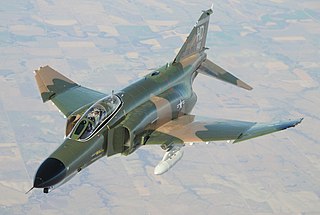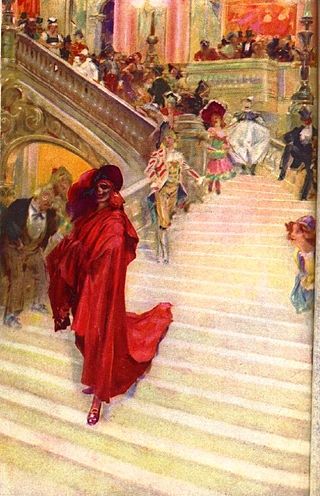
The McDonnell Douglas F-4 Phantom II is an American tandem two-seat, twin-engine, all-weather, long-range supersonic jet interceptor and fighter-bomber originally developed by McDonnell Aircraft for the United States Navy. Proving highly adaptable, it entered service with the Navy in 1961 before it was adopted by the United States Marine Corps and the United States Air Force, and by the mid-1960s it had become a major part of their air arms. Phantom production ran from 1958 to 1981 with a total of 5,195 aircraft built, making it the most produced American supersonic military aircraft in history, and cementing its position as a signature combat aircraft of the Cold War.

The McDonnell FH Phantom is a twinjet fighter aircraft designed and first flown during World War II for the United States Navy. The Phantom was the first purely jet-powered aircraft to land on an American aircraft carrier and the first jet deployed by the United States Marine Corps. Although only 62 FH-1s were built it helped prove the viability of carrier-based jet fighters. As McDonnell's first successful fighter, it led to the development of the follow-on F2H Banshee, which was one of the two most important naval jet fighters of the Korean War; combined, the two established McDonnell as an important supplier of navy aircraft.

The Phantom of the Opera is a novel by French author Gaston Leroux. It was first published as a serial in Le Gaulois from 23 September 1909 to 8 January 1910, and was released in volume form in late March 1910 by Pierre Lafitte. The novel is partly inspired by historical events at the Paris Opera during the nineteenth century, and by an apocryphal tale concerning the use of a former ballet pupil's skeleton in Carl Maria von Weber's 1841 production of Der Freischütz. It has been successfully adapted into various stage and film adaptations, most notable of which are the 1925 film depiction featuring Lon Chaney, and Andrew Lloyd Webber's 1986 musical.

The Phantom is an American adventure comic strip, first published by Lee Falk in February 1936. The main character, the Phantom, is a fictional costumed crime-fighter who operates from the fictional African country of Bangalla. The character has been adapted for television, film and video games.

The Phantom of the Opera is a musical with music by Andrew Lloyd Webber, lyrics by Charles Hart, additional lyrics by Richard Stilgoe and a libretto by Lloyd Webber and Stilgoe. Based on the 1910 French novel of the same name by Gaston Leroux, it tells the tragic story of a beautiful soprano, Christine Daaé, who becomes the obsession of a mysterious, masked musical genius living in the subterranean labyrinth beneath the Paris Opéra House.

The Phantom of the Opera is a 2004 musical romantic drama film based on Andrew Lloyd Webber's 1986 musical of the same name, which in turn is based on the 1910 French novel Le Fantôme de l'Opéra by Gaston Leroux. Produced and co-written by Lloyd Webber and directed by Joel Schumacher, it stars Gerard Butler in the title role, with Emmy Rossum, Patrick Wilson, Miranda Richardson, Minnie Driver, Simon Callow, Ciarán Hinds, Victor McGuire, and Jennifer Ellison in supporting roles.

Vilayanur Subramanian Ramachandran is an Indian-American neuroscientist. He is known for his wide-ranging experiments and theories in behavioral neurology, including the invention of the mirror box. Ramachandran is a distinguished professor in UCSD's Department of Psychology, where he is the director of the Center for Brain and Cognition.

Danny Phantom is an American animated superhero action adventure television series created by Butch Hartman for Nickelodeon. The series premiered on April 3, 2004, right after the 2004 Kids' Choice Awards, and ended on August 24, 2007. The series follows Danny Fenton, a teenage boy who, after an accident with an unpredictable portal between the human world and the "Ghost Zone", becomes a human-ghost hybrid and takes on the task of saving his town from subsequent ghost attacks using an evolving variety of supernatural powers. Danny is aided in his quest by his two best friends, Sam Manson and Tucker Foley, and later by his older sister Jazz, who for most of the series' run are among the only people who know of his double life.

Tom Tyler was an American actor known for his leading roles in low-budget Western films in the silent and sound eras, and for his portrayal of superhero Captain Marvel in the 1941 serial film The Adventures of Captain Marvel. Tyler also played Kharis in 1940's The Mummy's Hand, a popular Universal Studios monster film.
Phantom Records was an Australian record store and independent record label established in 1978 on Pitt Street in Sydney. Phantom Records was one of Australia's first indie labels, and the store was known for its guerilla marketing strategies.

Rolls-Royce Limited was a British luxury car and later an aero-engine manufacturing business established in 1904 in Manchester by the partnership of Charles Rolls and Henry Royce. Building on Royce's good reputation established with his cranes, they quickly developed a reputation for superior engineering by manufacturing the "best car in the world". The business was incorporated as "Rolls-Royce Limited" in 1906, and a new factory in Derby was opened in 1908. The First World War brought the company into manufacturing aero-engines. Joint development of jet engines began in 1940, and they entered production in 1944. Rolls-Royce has since built an enduring reputation for the development and manufacturing of engines for military and commercial aircraft.
Phantom vibration syndrome or phantom ringing syndrome is the perception that one's mobile phone is vibrating or ringing when it is not. Other terms for this concept include ringxiety, fauxcellarm and phonetom and phantom phone signals. According to Michael Rothberg, the term is not a syndrome, but is better characterised as a tactile hallucination since the brain perceives a sensation that is not actually present. WebMD published an article on phantom vibration syndrome with Rothberg as a source. Several other articles have been published in 2010s, including in NPR, Bustle, CBS News, and Psychology Today.

The Phantom is a British sailing dinghy that was designed by Paul Wright and Brian Taylor as a one-design racer and first built in 1971.

The Boeing Phantom Eye was a high altitude, long endurance (HALE) liquid hydrogen-powered unmanned aerial vehicle developed by Boeing Phantom Works. The aircraft was Boeing's proposal to meet the demand from the US military for unmanned drones designed to provide advanced intelligence and reconnaissance work, driven by the combat conditions in Afghanistan in particular. In August 2016, the Phantom Eye demonstrator was disassembled for display at the Air Force Flight Test Museum.

The Boeing Phantom Ray is an American demonstration stealth unmanned combat air vehicle (UCAV) developed by Boeing using company funds. The autonomous Phantom Ray is a flying wing around the size of a conventional fighter jet, and first flew in April 2011. It will conduct a program of test flights involving surveillance, ground attack and autonomous aerial refueling missions. The developers say it can carry 4,500 pounds of payload.

The Royal Australian Air Force (RAAF) operated 24 McDonnell Douglas F-4E Phantom II fighter-bomber aircraft in the ground attack role between 1970 and 1973. The Phantoms were leased from the United States Air Force (USAF) as an interim measure owing to delays in the delivery of the RAAF's 24 General Dynamics F-111C bombers. The F-4Es were considered successful in this role, but the government did not agree to a proposal from the RAAF to retain the aircraft after the F-111s entered service in 1973.

The United Kingdom (UK) operated the McDonnell Douglas F-4 Phantom II as one of its principal combat aircraft from 1968 to 1992. The UK was the first export customer for the F-4 Phantom, which was ordered in the context of political and economic difficulties around British designs for the roles that it eventually undertook. The Phantom was procured to serve in both the Royal Navy's Fleet Air Arm (FAA) and the Royal Air Force (RAF) in several roles including air defence, close air support, low-level strike and tactical reconnaissance.

The DJI Phantom is a series of unmanned aerial vehicles (UAVs), typically quadcopters, developed by Chinese technology company DJI. DJI Phantom devices were released between 2013 and 2019.
The Flying Phantom Essentiel,, is a French hydrofoil catamaran sailing dinghy that was designed by Gonzalo Redondo and Martin Fischer and first built in 2017.
















